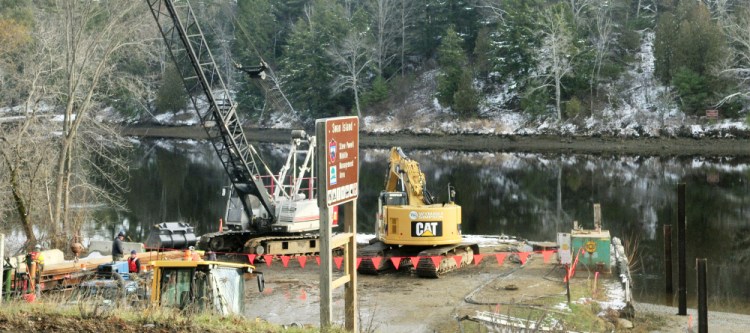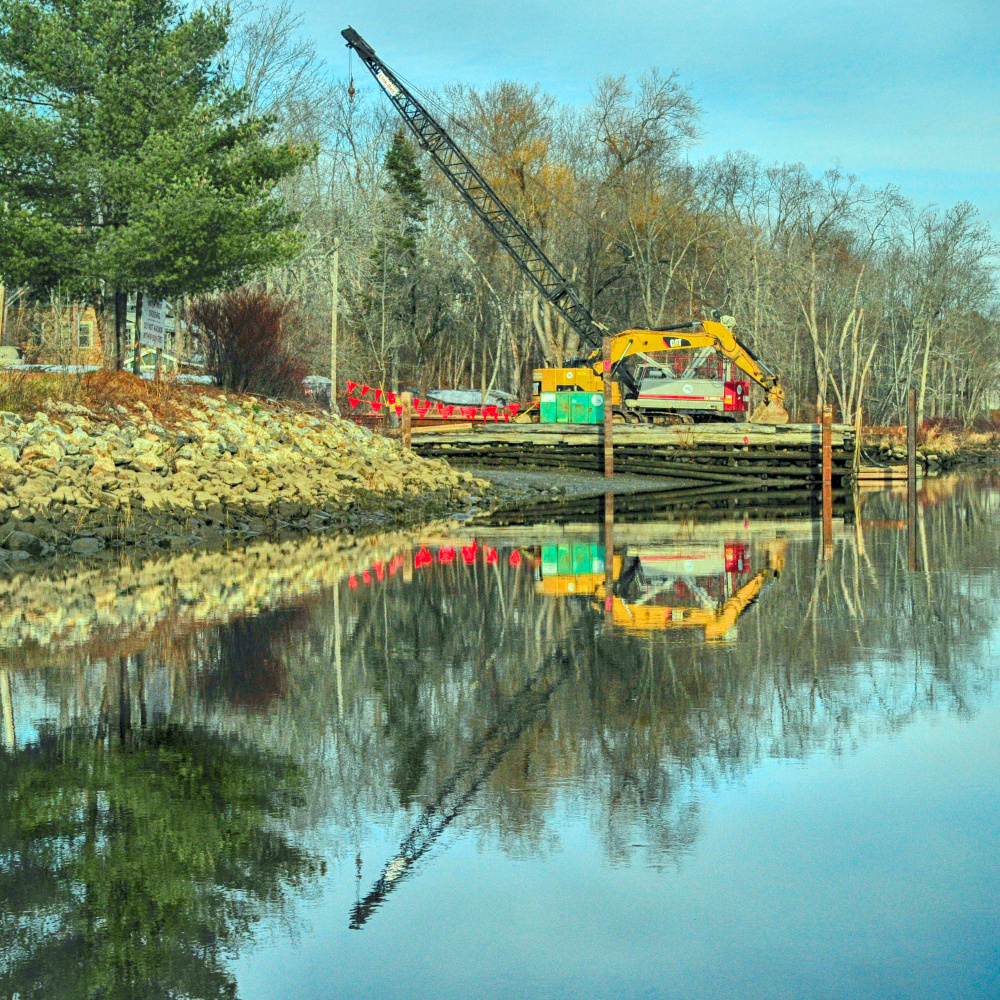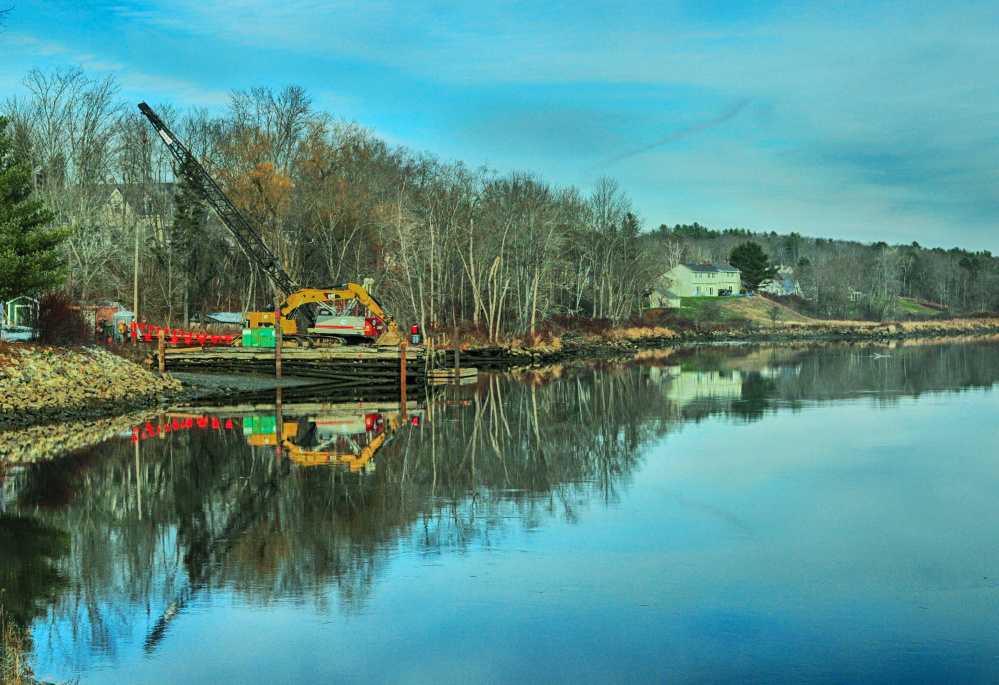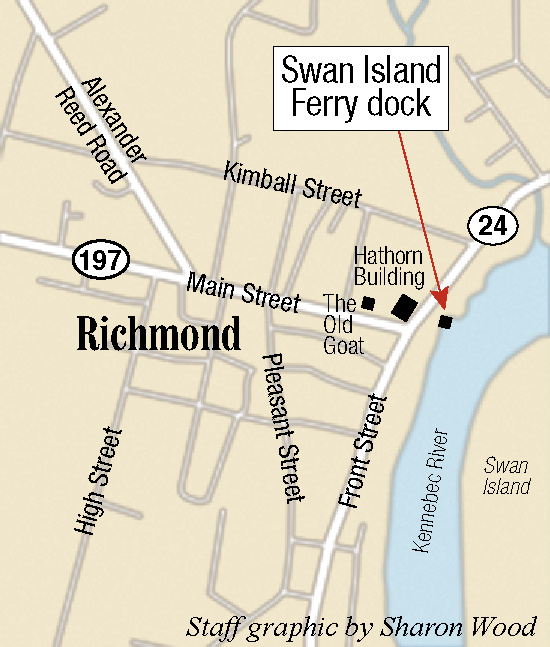RICHMOND — In the gusting wind and spitting snow, workers from Wyman and Simpson kept up a steady pace of work at the boat landing at the north end of Richmond’s waterfront on the Kennebec River Friday.
They are in the early stages of a project that will replace the wooden bulkhead that supports the boat landing where the ferry to Swan Island docks.
By the time the ferry starts its season in the spring, the bulkhead will have been replaced with a concrete version.
“We got 35 years out of the existing one,” John Pratte said. “With the new one, we’ll probably get 50 or more years.”
Pratte, a wildlife biologist with the Maine Department of Inland Fisheries and Wildlife, manages the island with its historic buildings and native wildlife population, and that includes the landing where the ferry launches, as well as the larger wildlife management area around the island.
“We’re always looking for new improvements,” Pratte said.
This has been Pratte’s third year managing the 4-mile long Swan Island and third year of implementing a strategic plan to increase interest in the island and the recreation opportunities it presents. Located at the head of Merrymeeting Bay on the Kennebec River between Richmond and Dresden, the island is a state wildlife management area that offers hiking trails, camping and restrooms to visitors as well as a glimpse of its history. In the mid-1800s, the island was home to the town of Perkins for a little less than a century.
Pratte said visits to the island recreation area reached their lowest number in 2013.
In 2015, the state replaced the 54-year-old wooden ferry serving the island with a larger, modern aluminum ferry. And in 2016, a series of events, including lobster bakes, were scheduled to help introduce more people to what the island has to offer.
While the number of visitors has increased by 134 percent, Pratte said it hasn’t yet reached the goal identified in the strategic plan. Drawing visitors to the island is important because visitor fees — $8 for a day visit, $20 to camp or book a picnic shelter — pay for two summer staff and some projects and it allows the island to be financially self-sufficient. The island also serves as a mechanism for outreach and education on wildlife topics in general and wildlife management techniques that can be used on private land across Maine.
The construction project, which is expected to cost about $290,000, will improve a few things. The project will raise the level of the boat landing on the west bank of the Kennebec River by 8 to 10 inches and contour the space to take care of some erosion and reduce sedimentation in the river from storm water runoff.
“There are times right now when we have high water events when the dock can’t float high enough,” Pratte said. Raising the level will fix that.
The Wyman and Simpson workers are driving sheet pilings into the river bed to create a watertight barrier around their work area. They can, Pratte said, pump out the water and create a dry space that will allow them to pull out the existing timbers without having to work in the river. They will also be able to lay the foundation for and install the concrete bulkhead.
Pratte said the company moved a crane in last week to start to drive in the sheet pilings. After the contained area is de-watered, the work is expected to take about a month.
The project was timed to take place after ferry service had halted for the year. But more importantly, the timing means that the endangered Atlantic and shortnose sturgeon that are found in the Kennebec River will be undisturbed.
The timing is working well in another respect.
Richmond has been working to increase the town’s attractiveness and improve the waterfront. Recently, Town Manager Janet Smith said town officials have been working to secure grants to pay for larger floats for the waterfront that can accommodate visiting boats up to 27 feet long. Eventually, a walkway linking the boat landings is anticipated as well as storage for kayaks and canoes.
That, town officials say, is expected to bolster businesses within an easy walk of the waterfront.
And it’s already happening.
Barbara Bowley, co-owner of Annabella’s Bakery and Cafe, said the summer programs offered at the island have created more business for the restaurant.
“It helps that we’re right across the street from the waterfront,” Bowley said Friday.
During the season, she said, people from out of town stop in for coffee and pastries and some have made return trips.
“We’ve also done a couple of events over there where we provided pastries,” she said.
All of the work of the project now underway will take place within the existing footprint of the landing. Pratte said an electrical pole will be removed and some things will be relocated. In the end, he said, they’ll gain four or five parking spaces.
The project is being paid for by federal Pittman Robertson funds that are derived from sales tax paid on hunting equipment, as well as North American Conservation Act funds. That money is matched by state funds from sale of hunting and trapping licenses.
The ferry season opens mid-May and continues to the fall.
People may take their own boats to the island and pay at the iron ranger pay stations year-round.
Jessica Lowell — 621-5632
Twitter: @JLowellKJ
Send questions/comments to the editors.






Success. Please wait for the page to reload. If the page does not reload within 5 seconds, please refresh the page.
Enter your email and password to access comments.
Hi, to comment on stories you must . This profile is in addition to your subscription and website login.
Already have a commenting profile? .
Invalid username/password.
Please check your email to confirm and complete your registration.
Only subscribers are eligible to post comments. Please subscribe or login first for digital access. Here’s why.
Use the form below to reset your password. When you've submitted your account email, we will send an email with a reset code.